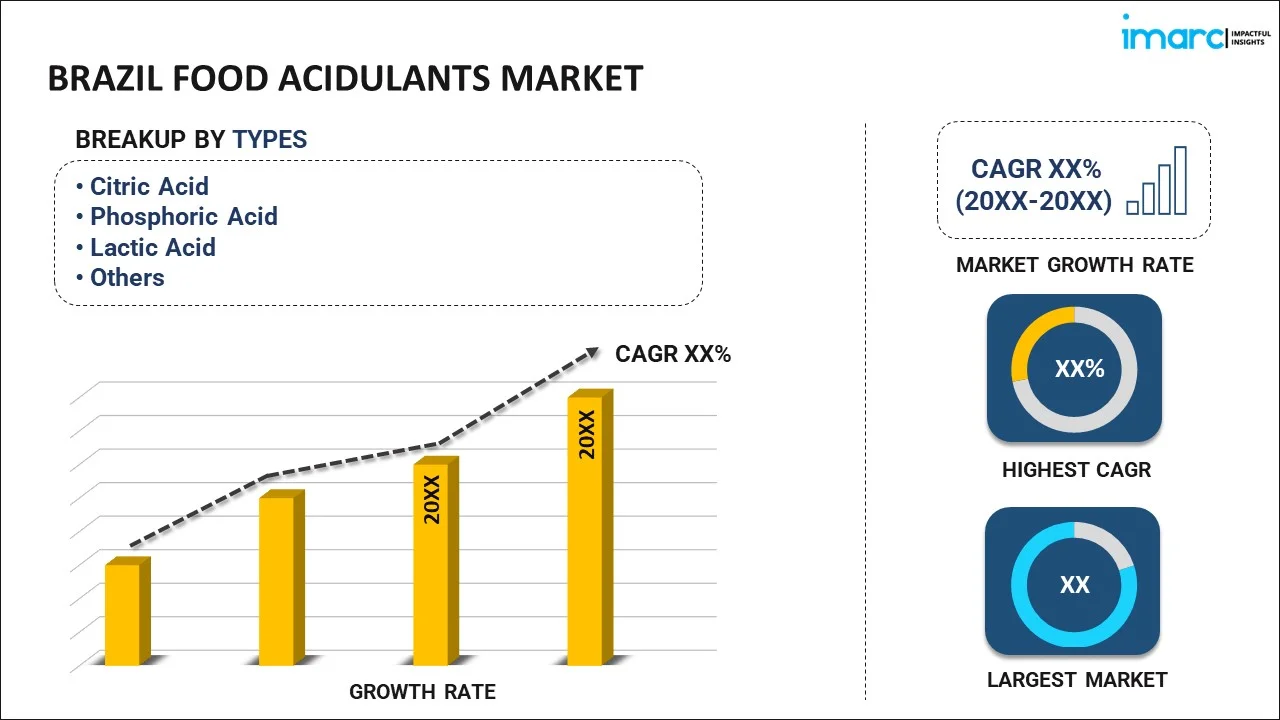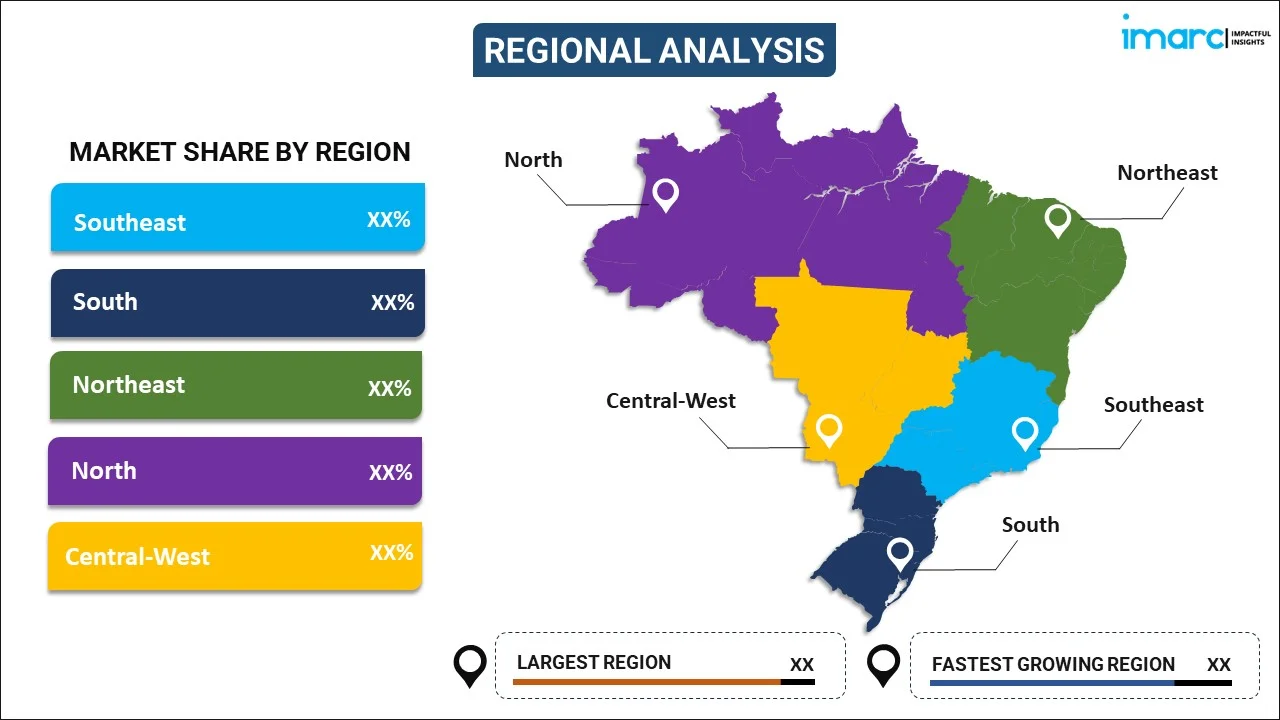
Brazil Food Acidulants Market Report by Type (Citric Acid, Phosphoric Acid, Lactic Acid, and Others), Application (Beverages, Dairy and Frozen Products, Bakery, Meat Industry, Confectionery, and Others), and Region 2025-2033
Market Overview:
Brazil food acidulants market size reached USD 264 Million in 2024. Looking forward, IMARC Group expects the market to reach USD 485.8 Million by 2033, exhibiting a growth rate (CAGR) of 6.3% during 2025-2033. The growing preferences of individuals for healthier and more natural food and beverage products, rising emphasis on cleaner and more transparent food labeling, and the expansion of hotels, restaurants, and cafes represent some of the key factors driving the market.
|
Report Attribute
|
Key Statistics
|
|---|---|
|
Base Year
|
2024 |
|
Forecast Years
|
2025-2033
|
|
Historical Years
|
2019-2024
|
| Market Size in 2024 | USD 264 Million |
| Market Forecast in 2033 | USD 485.8 Million |
| Market Growth Rate (2025-2033) | 6.3% |
Food acidulants have a neutral taste and offer stability under various storage conditions. They are available in multiple forms, including citric acid, tartaric, malic, and acetic acid. They help control and maintain the desired pH levels in food and beverages, ensuring product safety and stability. They aid in inhibiting the growth of harmful microorganisms and extending the shelf life of products. They help in maintaining the quality and safety of canned fruits, vegetables, and sauces. They are widely used in carbonated soft drinks, fruit juices, and sports beverages to provide tartness and enhance flavor. Besides this, they are also utilized in baking to activate leavening agents and improve texture in products like bread and cakes. Moreover, they find applications in dairy products like yogurt to adjust acidity and enhance taste.
Brazil Food Acidulants Market Trends:
Rising preferences of individuals for healthier and more natural food and beverage products represent one of the key factors augmenting the market growth in Brazil. Food acidulants, derived from various natural sources like fruits, are perceived as clean-label ingredients, which attracts health-conscious people who seek products with minimal artificial additives. Additionally, the growing emphasis on cleaner and more transparent food labeling is driving the demand for natural and recognizable ingredients. Furthermore, the increasing awareness among people about the health benefits associated with consuming foods rich in vitamin C is catalyzing the demand for food acidulants like citric acid in the country. Moreover, the expansion of the hotels, restaurants, and cafes in Brazil is another major factor facilitating the market growth. Apart from this, inflating income level of individuals is allowing them to spend more on packaged products, which is offering a favorable market outlook. Besides this, the rising trend of convenient and on-the-go consumption is driving the demand for processed and packaged foods in Brazil. Food acidulants are widely used for enhancing the flavor and preserving the quality of these products. In addition, the increasing focus of people on eco-friendly practices is encouraging manufacturers operating in the country to adopt sustainable sourcing and production methods, aligning with efforts to reduce environmental impact. Furthermore, the country is increasingly exporting its products to international markets, which is catalyzing the demand for food acidulants to meet international quality and taste standards, making Brazilian exports more competitive globally. Moreover, governing agencies are imposing stringent food safety regulations and standards, which is promoting the adoption of food acidulants and stimulating the market growth.
Brazil Food Acidulants Market Segmentation:
IMARC Group provides an analysis of the key trends in each segment of the market, along with forecasts at the country level for 2025-2033. Our report has categorized the market based on type and application.
Type Insights:

- Citric Acid
- Phosphoric Acid
- Lactic Acid
- Others
The report has provided a detailed breakup and analysis of the market based on the type. This includes citric acid, phosphoric acid, lactic acid, and others.
Application Insights:
- Beverages
- Dairy and Frozen Products
- Bakery
- Meat Industry
- Confectionery
- Others
A detailed breakup and analysis of the market based on the application have also been provided in the report. This includes beverages, dairy and frozen products, bakery, meat industry, confectionery, and others.
Regional Insights:

- Southeast
- South
- Northeast
- North
- Central-West
The report has also provided a comprehensive analysis of all the major regional markets, which include Southeast, South, Northeast, North, and Central-West.
Competitive Landscape:
The market research report has also provided a comprehensive analysis of the competitive landscape in the market. Competitive analysis such as market structure, key player positioning, top winning strategies, competitive dashboard, and company evaluation quadrant has been covered in the report. Also, detailed profiles of all major companies have been provided.
Brazil Food Acidulants Market Report Coverage:
| Report Features | Details |
|---|---|
| Base Year of the Analysis | 2024 |
| Historical Period | 2019-2024 |
| Forecast Period | 2025-2033 |
| Units | Million USD |
| Scope of the Report | Exploration of Historical Trends and Market Outlook, Industry Catalysts and Challenges, Segment-Wise Historical and Future Market Assessment:
|
| Types Covered | Citric Acid, Phosphoric Acid, Lactic Acid, Others |
| Applications Covered | Beverages, Dairy and Frozen Products, Bakery, Meat Industry, Confectionery, Others |
| Regions Covered | Southeast, South, Northeast, North, Central-West |
| Customization Scope | 10% Free Customization |
| Post-Sale Analyst Support | 10-12 Weeks |
| Delivery Format | PDF and Excel through Email (We can also provide the editable version of the report in PPT/Word format on special request) |
Key Questions Answered in This Report:
- How has the Brazil food acidulants market performed so far and how will it perform in the coming years?
- What has been the impact of COVID-18 on the Brazil food acidulants market?
- What is the breakup of the Brazil food acidulants market on the basis of type?
- What is the breakup of the Brazil food acidulants market on the basis of application?
- What are the various stages in the value chain of the Brazil food acidulants market?
- What are the key driving factors and challenges in the Brazil food acidulants?
- What is the structure of the Brazil food acidulants market and who are the key players?
- What is the degree of competition in the Brazil food acidulants market?
Key Benefits for Stakeholders:
- IMARC’s industry report offers a comprehensive quantitative analysis of various market segments, historical and current market trends, market forecasts, and dynamics of the Brazil food acidulants market from 2019-2033.
- The research report provides the latest information on the market drivers, challenges, and opportunities in the Brazil food acidulants market.
- Porter's five forces analysis assist stakeholders in assessing the impact of new entrants, competitive rivalry, supplier power, buyer power, and the threat of substitution. It helps stakeholders to analyze the level of competition within the Brazil food acidulants industry and its attractiveness.
- Competitive landscape allows stakeholders to understand their competitive environment and provides an insight into the current positions of key players in the market.
Need more help?
- Speak to our experienced analysts for insights on the current market scenarios.
- Include additional segments and countries to customize the report as per your requirement.
- Gain an unparalleled competitive advantage in your domain by understanding how to utilize the report and positively impacting your operations and revenue.
- For further assistance, please connect with our analysts.
 Inquire Before Buying
Inquire Before Buying
 Speak to an Analyst
Speak to an Analyst
 Request Brochure
Request Brochure
 Request Customization
Request Customization




.webp)




.webp)












